| Vocademy |
Power Amplifiers
The ultimate goal of any amplifier is to deliver power. An audio amplifier needs to send power to the speaker, which moves air to create sufficient sound waves to hear. A radio transmitter needs to deliver power to an antenna to produce radio waves.
Class-A amplifiers are not usually suitable for power amplifiers. This is because the biasing that makes the amplifier work as a class-A amplifier causes a constant current to flow through the circuit. The result is that a class-A amplifier always produces 100% of its rated power 100% of the time. If you have a 1000 watt class-A audio amplifier (and some audiophiles do) the amplifier is producing 1000 watts even with the volume set to its lowest level. This requires large heat sinks to dissipate the heat that is generated. A more practical power amplifier produces only the power needed at the moment that it is needed.
A class-B amplifier meets the above needs. However, by definition, a class-B amplifier only operates on ½, or 180 degrees, of the AC signal. This means that a class-B amplifier is allowed to reverse bias the transistor during ½ of each cycle and, therefore, only operate on ½ of each cycle. This causes severe distortion of the signal, rendering it useless (except for certain circuits that can make use of a highly distorted signal).
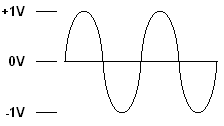 |
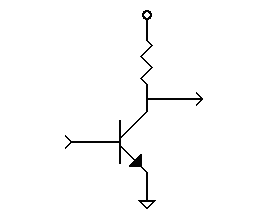 |
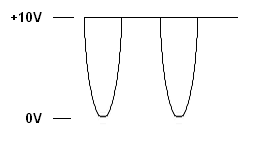 |
||
| AC input to amplifier |
Class-B amplifier (notice no biasing
network on the base). |
Distorted output for amplifier. Only 180 degrees of the signal is passed by the amplifier. |
The solution to this problem is a class-B push-pull amplifier. This is an arrangement where two class-B amplifiers work on alternate halves of the signal. This can be done through two approaches. One is to use two identical common-emitter amplifiers with transformer coupling.
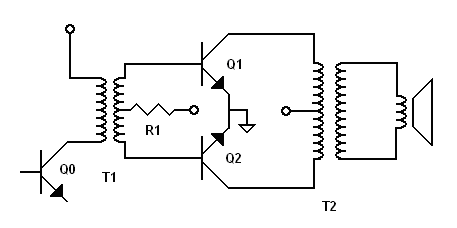 |
| A Class-B push-pull power amplifier with transformer coupling. |
The first transformer (T1) takes the place of the collector resistor in the driver circuit (the small-signal amplifier that feeds the power amplifier), as shown above. One transistor (Q1) amplifies the positive half of the input signal and the other transistor (Q2) amplifies the negative half of the signal. When Q1 is conducting, Q2 is in cut-off and vice versa.
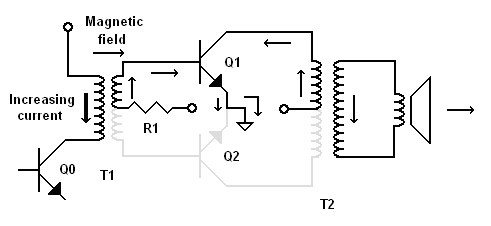 |
|
As the current increases in Q0, that current passes through the primary of T1. The magnetic field enlarges[1] and moves across the secondary of T1. This causes a current in the secondary that turns on Q1, which amplifies the positive half of the signal. Q2 is cut-off so no current flows in its part of the circuit. |
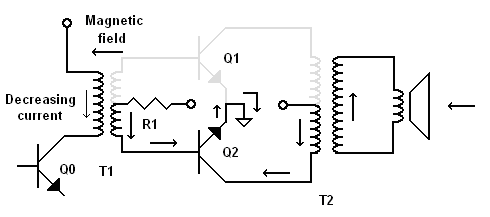 |
| As the current decreases in Q0, the magnetic field shrinks and therefore reverses direction across the secondary of T1. This causes a current in the secondary that turns on Q2 and amplifies the negative half of the signal. Q1 is cut-off, so no current flows in its part of the circuit. |
The second transformer (T2) takes the place of collector resistors in the power amplifier. During the positive half of the cycle, current flows in the upper half of the transformer's primary winding. This causes current to flow in the secondary, through the speaker. In the diagram, the speaker cone is shown being pushed outward. During the negative half of the cycle, current flows in the lower half of the transformer's primary winding. This time the current if flowing in the opposite direction. Therefore, the current in the secondary if flowing in the opposite direction, completing the cycle in the secondary of the transformer and the speaker. The diagram shows the speaker cone being pulled in.
The resistor (R1) is selected to bias the transistors just to the point of beginning to conduct. This causes one transistor to begin conducting just as the other is reaching its cut-off point. This prevents there being a short period (while the input signal is near 0 volts) where neither transistor is conducting, which causes distortion of the signal called crossover distortion.
 |
| A sine wave with crossover distortion |
Another approach is a class-B push-pull amplifier using complementary-pair transistors in a common-collector configuration. This type of amplifier does not require transformers. Instead, matching NPN and PNP transistors operate on alternate halves of the signal. Manufacturers make certain pairs of NPN and PNP transistors with matching characteristics and opposite polarities just for such a purpose.
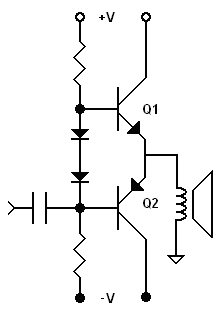 |
| A transformerless Class-B push-pull power amplifier |
With the transformerless class-B push-pull amplifier, on the positive half of the cycle the top transistor will conduct pushing conventional current through the speaker. During the negative half of the cycle conventional current will flow from the circuit ground, through the speaker and the bottom transistor to the negative power supply.
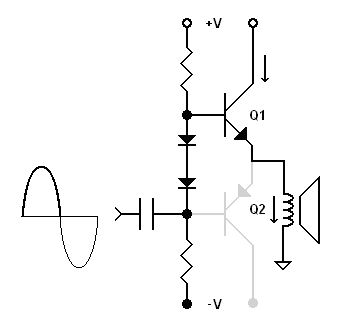 |
|
Q1 conducts during the positive half of the
cycle. |
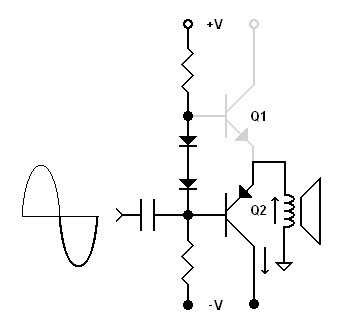 |
| Q2 conducts during the negative half of the cycle. |
The two diodes between the bases of the transistors prevent crossover distortion. Without them, the top transistor (Q1) begins to conduct when the signal voltage rises above +0.7 volts. The bottom transistor begins to conduct when the signal voltage drops below -0.7 volts. When the input signal is between these two voltages—near 0 volts—both transistors are cut-off and nothing is making it to the speaker. This would cause crossover distortion if nothing were done to prevent it. The two diodes at the input cause the base of the bottom transistor always to be 1.4 volts lower than the base of the top transistor. When the input signal voltage is at 0 volts, the voltage at the base of Q1 is already at +0.7 volts. The transistor will come out of cut-off is the signal voltage rises any higher. At the same time, the voltage at the base of Q2 is at -0.7 volts. Q2 will come out of cut-off if the signal voltage goes any lower. If the input signal voltage goes above 0 volts Q1 starts to conduct. If the voltage goes below 0 volts, Q2 starts to conduct.
Clarification:
Some people have been confused because they see the signal going through the capacitor, then through the diodes and finally to the base of Q1. However, this appears to be impossible because the signal is traveling the wrong way through the two diodes. Remember that signal travel is independent of current direction. In other words, information can and often does travel in the opposite direction of the current. In the above case, the voltage at the base of Q2 is going up and down. The voltage base of Q1 (at the top of the diode stack) will always be approximately 1.4 volts higher than the base of Q2. Therefore, as the voltage at the base of Q2 goes up and down, so does the voltage at the base of Q1 by the same amount. The current, which is a physical entity, may only be able to go top-to-bottom, but the signal, the nonphysical information, goes right through the diodes in the direction impossible for the current.
The disadvantage of this circuit is that it requires two power supplies. This is a problem when designing an amplifier that runs on batteries. However, this design is often preferred for mains-powered equipment where dual power supplies is not a major design issue.
—————————
| Vocademy |
